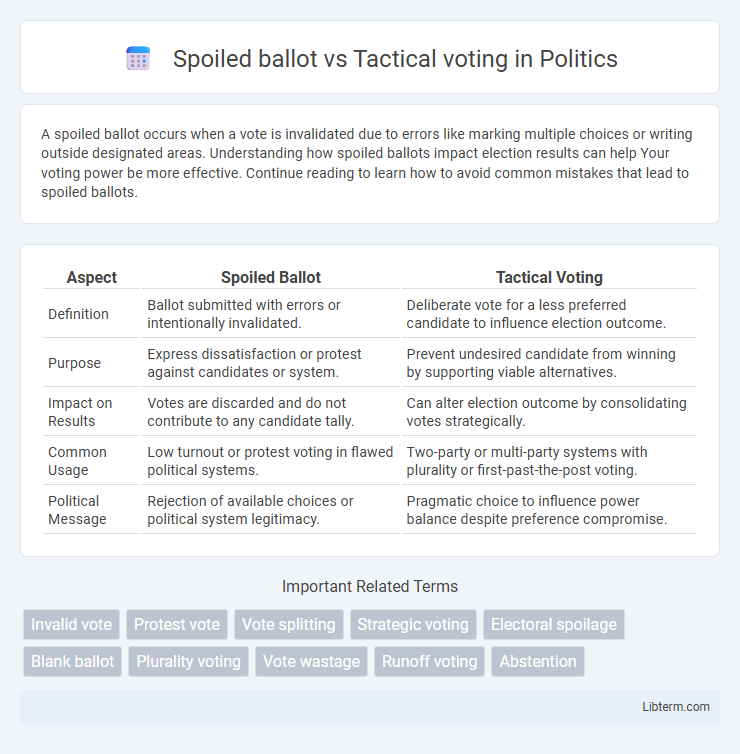A spoiled ballot occurs when a vote is invalidated due to errors like marking multiple choices or writing outside designated areas. Understanding how spoiled ballots impact election results can help Your voting power be more effective. Continue reading to learn how to avoid common mistakes that lead to spoiled ballots.
Table of Comparison
| Aspect | Spoiled Ballot | Tactical Voting |
|---|---|---|
| Definition | Ballot submitted with errors or intentionally invalidated. | Deliberate vote for a less preferred candidate to influence election outcome. |
| Purpose | Express dissatisfaction or protest against candidates or system. | Prevent undesired candidate from winning by supporting viable alternatives. |
| Impact on Results | Votes are discarded and do not contribute to any candidate tally. | Can alter election outcome by consolidating votes strategically. |
| Common Usage | Low turnout or protest voting in flawed political systems. | Two-party or multi-party systems with plurality or first-past-the-post voting. |
| Political Message | Rejection of available choices or political system legitimacy. | Pragmatic choice to influence power balance despite preference compromise. |
Understanding Spoiled Ballots
Spoiled ballots occur when votes are incorrectly marked, making them invalid for counting, often due to voter errors or confusion about voting instructions. Understanding spoiled ballots is essential to improve election accuracy and voter education, reducing unintentional disenfranchisement. Unlike tactical voting, which involves strategic candidate selection to influence outcomes, spoiled ballots represent accidental or deliberate invalidation of a vote.
What Is Tactical Voting?
Tactical voting involves casting a ballot not for a preferred candidate but for one with a better chance of winning, aiming to prevent an undesirable outcome. Unlike spoiled ballots, which are intentionally or accidentally invalidated and do not count toward any candidate, tactical voting strategically influences election results. This practice is common in plurality voting systems where voters seek to maximize the impact of their vote against less favored contenders.
Key Differences: Spoiled Ballots vs Tactical Voting
Spoiled ballots occur when voters intentionally or accidentally submit invalid ballots that do not count towards any candidate, often as a form of protest or error, whereas tactical voting involves deliberately choosing a less preferred but more viable candidate to influence election outcomes strategically. Spoiled ballots reduce the total valid votes and can signal voter dissatisfaction, while tactical voting actively impacts the distribution of votes and can alter which candidates advance or win. Understanding these key differences highlights how voter behavior can either undermine or strategically navigate the electoral process.
Why Do Voters Spoil Ballots?
Voters spoil ballots primarily due to confusion over voting procedures, intentional protest against all candidates, or dissatisfaction with the political options presented. Spoiled ballots can result from incorrectly marked choices, leaving sections blank, or deliberately defacing the ballot to signal disapproval. Understanding the reasons behind spoiled ballots helps electoral systems address voter education gaps and improve ballot design to minimize invalid votes.
Motivations Behind Tactical Voting
Tactical voting is driven by voters' desire to maximize the impact of their vote by supporting a candidate with a realistic chance of winning rather than their top preference, often to prevent an undesirable candidate from gaining power. Spoiled ballots, by contrast, usually represent protest votes or voter errors rather than strategic decisions. Motivations behind tactical voting include minimizing wasted votes, influencing election outcomes, and navigating first-past-the-post systems to avoid vote splitting among similar candidates.
Impact on Election Outcomes
Spoiled ballots, resulting from voter errors or intentional invalidation, reduce the total valid votes, potentially skewing election outcomes by lowering the vote share of specific candidates or parties. Tactical voting, where voters select a less preferred but more viable candidate to prevent an undesired outcome, can consolidate support and shift results in closely contested races. Both phenomena significantly influence election dynamics by altering vote distributions, sometimes changing the winner in marginal constituencies.
Legal and Ethical Considerations
Spoiled ballots, often resulting from voter errors or intentional protest, raise legal issues regarding vote validity and election integrity, with some jurisdictions imposing penalties for deliberate spoilage. Tactical voting involves selecting a less-preferred but more viable candidate to influence electoral outcomes, challenging ethical norms around voter sincerity and democratic representation. Both practices underscore the tension between individual voter autonomy and the collective goal of fair, transparent elections.
Historical Examples and Trends
Historical examples of spoiled ballots include the 2000 U.S. presidential election, where many disputed ballots in Florida led to widespread voter confusion and legal battles, highlighting the consequences of unclear ballot design. Tactical voting has notably influenced outcomes in the 1997 UK general election, where voters supported the Labour Party to prevent a Conservative win, reflecting strategic behavior to avoid vote splitting. Trends show that spoiled ballots often surge in tightly contested elections with complex ballots, while tactical voting becomes more prominent in plurality or first-past-the-post systems where voters seek to maximize the impact of their vote.
Voter Education and Awareness
Voter education plays a crucial role in reducing spoiled ballots by informing voters about correct ballot marking procedures and the consequences of invalid votes. Tactical voting awareness helps voters understand how strategic choices can influence election outcomes, empowering them to cast ballots that truly reflect their political preferences. Comprehensive voter awareness campaigns enhance electoral participation accuracy and promote informed decision-making in democratic processes.
Implications for Future Elections
Spoiled ballots can distort election outcomes by reducing the total count of valid votes, potentially impacting seat allocation and undermining electoral legitimacy. Tactical voting influences election results by encouraging voters to support less preferred but more viable candidates to prevent undesired outcomes, which can skew true voter preferences. Both phenomena affect party strategies and voter behavior analysis, necessitating reforms like improved voter education and transparent ballot design to enhance future election integrity.
Spoiled ballot Infographic

 libterm.com
libterm.com